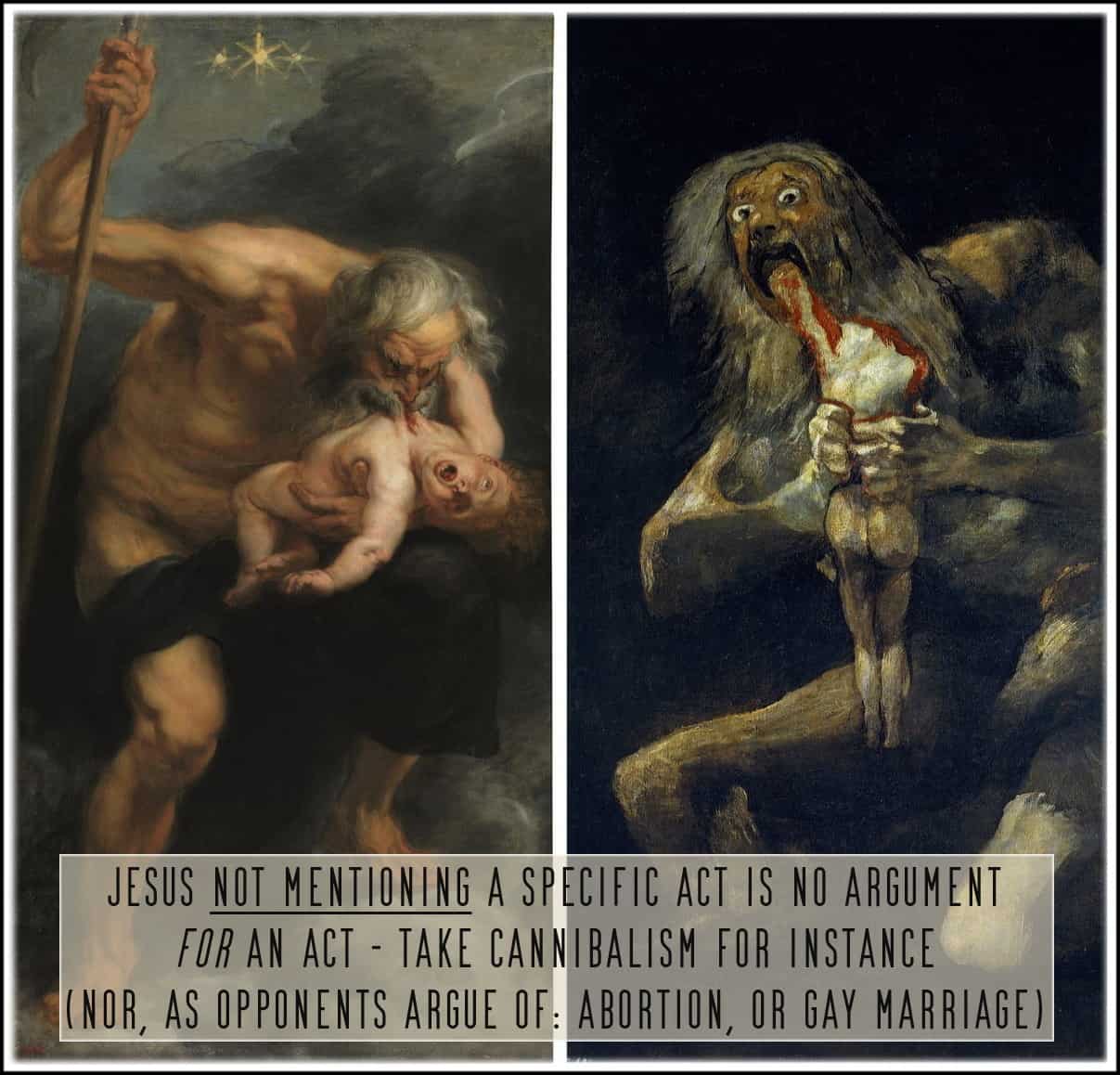 I saw a version of this via Facebook (to the right, click to expand in another window), but I thought it zeroed in on just one debate rather than allowing for use in a more general sense while also mentioning the “BIG TWO” — which is the abortion debate and same-sex-marriage. Not to mention that the color choice for the text is hard to read.
I saw a version of this via Facebook (to the right, click to expand in another window), but I thought it zeroed in on just one debate rather than allowing for use in a more general sense while also mentioning the “BIG TWO” — which is the abortion debate and same-sex-marriage. Not to mention that the color choice for the text is hard to read.
- I really liked this, so I redesigned it a bit. Mind you, I think Jesus’ harkening back to Adam and Eve was a specific argument for heterosexual marriage/union, I like the idea of assuming the skeptics position and showing how deficient it is.
I chose a classic set of paintings of SATURN DEVOURING HIS SON. This story is a well-known Greek myth. The paintings chosen are by Peter Paul Rubens (left) and Francisco Goya (right).
Here are some of my posts dealing with the “BIG-TWO.”
ABORTION
- Politics According to the Bible (Exodus 21:22) ~ Pro-Life
- Bullet Points On the Pro-Choice/Pro-Life Argument
- When Does Life Begin? (+Potential Life?)
HISTORICAL PIVOT
SAME-SEX MARRIAGE (SSM)
- Same-Sex Marriage | RPT’s Cumulative Case Against SSM
- Is Marriage Hetero?
- No Religious Or Ethical Leader In History Supported SSM
- RPT’s Position On Gay Men and Women
A quote regarding Natural Theory and cannibalism. First up is one of my oldest posts (pre-dating my time on this .com), and it is not “my” writing specifically — it is other sources I collated:
….Human beings also have other aspects to their nature, aspects that are not such noble features of their makeup. One is their method of sexual reproduction. And make no mistake: despite astonishing denials of organized homosexuality, human beings, as surely as deer or elephants, come equipped with a natural method of reproduction. Unlike in other species, however, these lower aspects in man share in man’s higher aspect, reason. The result is the virtue of temperance or self-control. The Founders of America understood that our rights stem from this capacity, the capacity for moral virtue.
Homosexuals like to argue that, since people are by nature free to choose, the choice of sodomy should be protected, at least as much as any other choice. However, the fact that people are free by nature to make choices does not mean that any choice they make is good or that all choices should be equal before the law. Some people choose to steal and lie. Some abandon their children or their wives or husbands. Some sink into the grip of drugs. Some evade the draft at their country’s need, or abandon their duty in the face of battle. These are bad choices, and when they are made, the rest of us must bear part of the cost. These things are wrong in a constitutional democracy, as much as they are wrong anywhere else.
On the other hand, liberal societies recognize that all sins cannot be, and must not be, punished under the law. A state powerful enough to do that is too powerful to control. That is why we are cautious in a free country, about telling others what to do. That is why Presidents often appeal to us to be upright, moral citizens, but they do not bring charges against us unless we break the law.
Still, we must not forget that democracies have the greatest in the practice of virtue by citizens, because in democracy the citizens themselves are the rulers. So it is that George Washington, one of the greatest moral examples in history, said in his First Inaugural Address: “There is no truth more thoroughly established than that there exists an indissoluble union between virtue and happiness…”
A liberal society might, then, find it prudent to ignore homosexuality. It might well deem it unwise to peer into private bedrooms. However, this is not the issue before us. Today the demand is that homosexuality be endorsed and promoted with the full power of the law. This would require us to abandon the standard of nature, the one standard that can teach us the difference between freedom and slavery, between right and wrong.
Once we abandon the standard of nature, what is to forbid us from resorting to any violation of nature that we please? Why should we not return to slavery, if we find it convenient? Or the practice of incest or adultery or cannibalism? Without an understanding that there is a higher law that limits human will – whether divine law or the “law of Nature or Nature’s God” which we can grasp through our reason – there is no basis to prohibit any activity. Anything becomes possible (which is why some [me included] refer to murder and homosexuality in the same stroke of the pen/keyboard, this analogy is now detailed in a more exhaustive manner above).
In fact, the rights sought by homosexual activists are not natural or constitutional rights (for the best chapter on this subject – why homosexuals should be fighting to keep the traditional definition of family – I suggest the book Relativism: Feet Planted Firmly in Mid-Air). They are the special rights granted ethnic minorities by affirmative action policies. These special rights would force businesses, schools, and virtually every institution in the land, public and private, to open their doors to homosexuals, and allow lawsuits to be brought against those that refuse….
And this excerpt as well from a counter conspiracy post of mine where I quote the indomitable David Berlinski:
DARWIN CONCEIVED OF EVOLUTION in terms of small variations among organisms, variations which by a process of accretion allow one species to change continuously into another. This suggests a view in which living creatures are spread out smoothly over the great manifold of biological possibilities, like colors merging imperceptibly in a color chart.
Life, however, is absolutely nothing like this. Wherever one looks there is singularity, quirkiness, oddness, defiant individuality, and just plain weirdness. The male redback spider (Latrodectus hasselti), for example, is often consumed during copulation. Such is sexual cannibalism the result, biologists have long assumed, of “predatory females overcoming the defenses of weaker males.” But it now appears that among Latrodectus hasselti, the male is complicit in his own consumption. Having achieved intromission, this schnook performs a characteristi somersault, placing his abdomen directly over his partner’s mouth. Such is sexual suicide—awfulness taken to a higher power.
It might seem that sexual suicide confers no advantage on the spider, the male passing from ecstasy to extinction in the course of one and the same act. But spiders willing to pay for love are apparently favored by female spiders (no surprise, there); and female spiders with whom they mate, entomologists claim, are less likely to mate again. The male spider perishes; his preposterous line persists.
This explanation resolves one question only at the cost of inviting another: why such bizarre behavior? In no other Latrodectus species does the male perform that obliging somersault, offering his partner the oblation of his life as well as his love. Are there general principles that specify sexual suicide among this species, but that forbid sexual suicide elsewhere? If so, what are they Once asked, such questions tend to multiply like party guests. If evolutionary theory cannot answer them, what, then, is its use? Why is the Pitcher plant carnivorous, but not the thorn bush, and why does the Pacific salmon require fresh water to spawn, but not the Chilean sea bass? Why has the British thrush learned to hammer snails upon rocks, but not the British blackbird, which often starves to death in the midst of plenty? Why did the firefly discover bioluminescence, but not the wasp or the warrior ant; why do the bees do their dance, but not the spider or the flies; and why are women, but not cats, born without the sleek tails that would make them even more alluring than they already are?
Why? Yes, why? The question, simple, clear, intellectually respectable, was put to the Nobel laureate George Wald. “Various organisms try various things,” he finally answered, his words functioning as a verbal shrug, “they keep what works and discard the rest.”
But suppose the manifold of life were to be given a good solid yank, so that the Chilean sea bass but not the Pacific salmon required fresh water to spawn, or that ants but not fireflies flickered enticingly at twilight, or that women but not cats were born with lush tails. What then? An inversion of life’s fundamental facts would, I suspect, present evolutionary biologists with few difficulties. Various organisms try various things. This idea is adapted to any contingency whatsoever, an interesting example of a Darwinian mechanism in the development of Darwinian thought itself.
A comparison with geology is instructive. No geological theory makes it possible to specify precisely a particular mountain’s shape; but the underlying process of upthrust and crumbling is well understood, and geologists can specify something like a mountain’s generic shape. This provides geological theory with a firm connection to reality. A mountain arranging itself in the shape of the letter “A” is not a physically possible object; it is excluded by geological theory.
The theory of evolution, by contrast, is incapable of ruling anything out of court. That job must be done by nature. But a theory that can confront any contingency with unflagging success cannot be falsified. Its control of the facts is an illusion.
- David Berlinski, The Deniable Darwin & Other Essays (Seattle, WA: Discovery Institute Press, 2009), 45-47.
